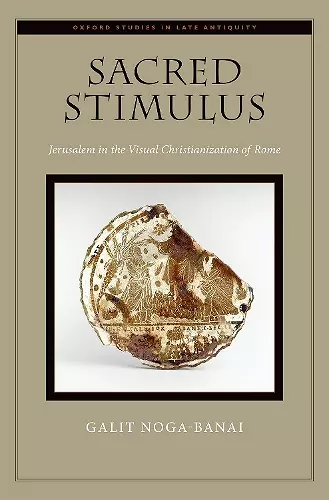Sacred Stimulus
Jerusalem in the Visual Christianization of Rome
Format:Hardback
Publisher:Oxford University Press Inc
Published:12th Jul '18
Currently unavailable, and unfortunately no date known when it will be back

Sacred Stimulus offers a thorough exploration of Jerusalem's role in the formation and formulation of Christian art in Rome during the fourth and fifth centuries. The visual vocabulary discussed by Galit Noga-Banai gives an alternative access point to the mnemonic efforts conceived while Rome converted to Christianity: not in comparison to pagan art in Rome, not as reflecting the struggle with the emergence of New Rome in the East (Constantinople), but rather as visual expressions of the confrontation with earthly Jerusalem and its holy places. After all, Jerusalem is where the formative events of Christianity occurred and were memorialized. Sacred Stimulus argues that, already in the second half of the fourth century, Rome constructed its own set of holy sites and foundational myths, while expropriating for its own use some of Jerusalem's sacred relics, legends, and sites. Relying upon well-known and central works of art, including mosaic decoration, sarcophagi, wall paintings, portable art, and architecture, Noga-Banai exposes the omnipresence of Jerusalem and its position in the genesis of Christian art in Rome. Noga-Banai's consideration of earthly Jerusalem as a conception that Rome used, or had to take into account, in constructing its own new Christian ideological and cultural topography of the past, sheds light on connections and analogies that have not necessarily been preserved in the written evidence, and offers solutions to long-standing questions regarding specific motifs and scenes.
Her careful reading of a variety of portable objects, funerary art, monumental pictorial programs, and architecture provides a new way of envisioning the visual development of Rome's sacred topography. * Kirstin Noreen, Loyola Marymount University, Speculum *
This exciting new monograph assesses the visual effect Jerusalem had on the making of Christian art in Rome from the first to the fifth century. No other book would parallel the Arch of Titus and the epigrams of Bishop Damasus -- Noga-Banai does this with brio and with solid argumentation to prove her thesis that the cultic and cultural memory of Jerusalem triggered new artistic solutions in Rome. The mnemonic bridges that the Church of Rome established with Jerusalem served to create the illusion of historical continuity and the appropriation of the status of 'holy city.' * Marianne Sághy, Central European University *
Noga-Banai's subject is excellent and innovative ... Should be a welcome addition to studies of the city of Rome and its Christian monumentalization, and a very good explanation on why we should consider visual knowledge side by side with textual knowledge. * Hagith Sivan, The University of Kansas *
When words fail images step up. Sacred Stimulus turns a finely-tuned ear to the faint echoes of a once strident conversation. In the visual polemics that Galit Noga-Banai detects in such works as the Samagher Casket, the Bethesda sarcophagi, and the apse mosaic of S. Pudenziana, she recognizes the designs of Roman patrons and artists intent on relocating Jerusalem to the banks of the Tiber. What surfaces is an adventurous romp through the loca sancta of two preeminent late antique cities and a new way of seeing familiar things. * Dennis Trout, University of Missouri *
ISBN: 9780190874650
Dimensions: 160mm x 236mm x 18mm
Weight: 540g
256 pages